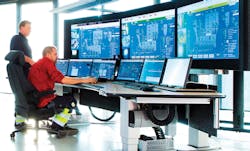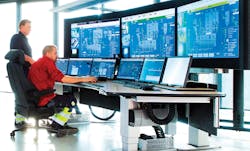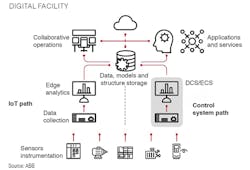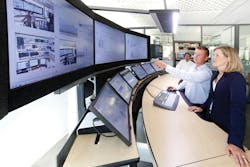Digitalization provides opportunities and challenges
Obstacles include lack of standardization, integration
Martin Grady, ABB
Oil andgas companies that take full advantage of the opportunities provided by digitalization stand to gain significantly in the coming years.
During the slump in oil prices over recent years, companies in the oil and gas industry were forced to explore new ways of working. Costs were cut aggressively, businesses merged, and new patterns of cooperation were developed. Now, oil prices are on the rise, but this does not signal the end of challenges for the industry.
Many of the new oil and gas fields now in line for development are in areas that are difficult to access and will require high oil prices just to break even. Add to this the challenge of energy transition, with renewable energy installations, equivalent to millions of tons of oil being added to the global energy system every year. The shift to renewables, along with the emergence of electric vehicles affecting the demand side, could lead to profits of $65-70 billion migrating from oil and gas companies to the broader energy ecosystem.
So, if lower costs and higher oil prices do not ensure the industry’s long-term well-being, what will? To achieve sustainable profitability, companies need to fully embrace digitalization. This will help optimize performance and reduce risks, while minimizing environmental impact. Digitalization means significant changes, and these are never easy. However, providing companies can overcome the hurdles that exist, there are significant upsides.
By using digital technologies in a meaningful way, oil and gas companies can reduce capex and opex by up to 30%. Projects can be completed up to 25% faster, with 40% fewer start-up and installation hours. The figures are based on ABB’s real-world achievements for oil and gas installations.
These improvements have been made possible by a number of technologies that are currently coming together. The most powerful enabler is the Industrial Internet of Things (IIOT), which comprises many standards by which components can communicate with each other, without human intervention. This way, machines can work faster and more efficiently.
Meanwhile, cloud-based technologies drive collaboration, enabling people and machines to work together in real time. Remote condition monitoring technologies give an understanding of processes as they happen so that the best decisions can be taken at any one time. Additionally, new digital technologies and the rise of artificial intelligence will enable totally new designs and concepts to develop.
A high level of automation means that processes run more smoothly. An automated plant can operate with fewer people on-site, particularly if they are backed up by experts in remote centers of excellence that can be called upon when abnormal situations arise.
(All images courtesy ABB)
Opportunities
To reap the full benefit of digitalization, anything at the plant that can be automated, should be. Machines process routine information quicker and more efficiently than human operators. A high level of automation means that processes run more smoothly. An automated plant can operate with fewer people on-site, particularly if they are backed up by experts in remote centers of excellence that can be called upon when abnormal situations arise.
One of the most powerful applications of the IIOT is the creation of digital twin applications. This is where data from the engineering database is used to create a virtual replica of equipment and processes. The information can be used to simulate the behavior of the physical object. This allows companies to test the software, operator interfaces, and safety features and to pre-tune the system, without involving any physical hardware. This removes the cost and the time associated with coupling up simulated I/O for functional testing of the application software.
Once a plant is up and running, there is usually scope for further process optimization. However, this is often overlooked due to time constraints and other pressures. If a digital twin has been used during commissioning, this should continue to be used. This way, any changes can be assessed, and the facility can be optimized on an ongoing basis, while also helping decision-makers choose between scenarios. Key performance indicators can be tracked using cloud-based solutions.
Less energy use reduces disruption
In addition, it will be easier to optimize energy usage. This reduces costs and improves environmental performance, while also making the plant more resilient to disruption, as the significance of any process disturbance is reduced in the event of the power supply being interrupted. Big data analytics can also be used to forecast energy import, load and trading variables, while measuring and analyzing energy efficiency performance.
Digitalization helps manage critical events and reduce risk. Analytics and artificial intelligence can be used to highlight and prioritize critical events, thereby preventing problems from escalating.
Predictive maintenance routines can also be improved. Traditional maintenance is based on service time, not actual requirements, despite the fact that 70 to 90% of failures are unrelated to the age of the equipment. This means that considerable effort is usually devoted to equipment that already works perfectly well. In reality, 80% of all issues are caused by just 20% of the equipment. In addition, 40% of production losses can be attributed to preventable operator error. By introducing more human involvement in areas where it is not needed, for instance, with unnecessary maintenance, we may reduce the reliability of the plant, rather than improve it.
Digital facilities are also better able to use collaboration within and across sites, as well as between operators and suppliers. This approach eliminates all disjointed silos of excellence and instead ensures that best practices are implemented across the board. The performance of the facility is optimized over the lifecycle, making it more agile, profitable, and environmentally sound.
If, during the plan and design phase, there is early engagement with the automation vendor, then it is highly likely that the correct technologies are selected, and new business models applied, to ensure a seamlessly operating digital facility.
Implementing digitalization at Norske Shell
An example of how a fully integrated approach to digitalization can improve performance can be found at Norske Shell. It has doubled the lifetime of aging topsides and subsea assets while delivering 99% uptime, ensuring high levels of safety and managing energy consumption more effectively.
Norske Shell operates the Ormen Lange field and until recently operated the Draugen field on the Norwegian continental shelf. The use of intelligent services extended the life of the safety and automation systems at the fields by an additional 20 years, by developing an upgrade or replacement path for each item of hardware and software. The plan minimizes risk and expenditure, while safeguarding Shell’s existing high availability.
Furthermore, thousands of hours of work are performed annually by authorized ABB personnel from remote monitoring and operations rooms at the company’s locations in Norway. This remote access enables ABB to safely implement changes, troubleshoot, provide support and carry out health checks, reducing the burden on Shell.
Obstacles
Today, as many as 64% of oil and gas projects suffer from cost overruns and 73% have scheduling delays. Intelligent project execution and collaborative operation can significantly change such figures for the better. So why have not all oil and gas companies already gone digital?
One significant hurdle is the lack of standardization. Much of the data coming from sensors is not standardized or integrated across platforms. To improve performance, oil and gas companies need to embrace proven digital strategies of other industries.
Furthermore, oil and gas companies have not, traditionally, been very good at sharing data, not even between departments. This must change. For digitalization to deliver all its potential benefits, it must be better integrated, with systems, equipment, and sensors from across the value chain sharing data and learning from each other. Many sites still rely on spreadsheets, combined with human expertise, for crucial decision support.
Information and operation technologies (IT and OT) cannot operate in silos if the industry wants to draw the full benefits from an integrated approach to power, automation, and telecom systems, such as remote asset diagnostics, continuous automation, and production optimization.
Improved cyber security
Added to this is the issue of cyber security, which needs to come higher up the agenda. Many traditional cyber security best practices do not apply to industrial control systems. Businesses have to exercise due diligence in the operational use of data and foster a greater understanding of the useful practices that are needed here. Companies need to ensure that they operate adequate cyber security standards and keep up to date with security patch and malware protection management.
As has happened in other industries, oil and gas companies may also need to change their business models. This includes focusing on the most profitable assets, gaining efficiencies from replicating standardized designs and processes, increasing automation, and outsourcing some core functions.
It is also a matter of culture and mindset. Executives in this industry often prioritize traditional areas such as geology, well services, and turbomachinery. In the future, automation and digital technologies need to have higher priority.
Furthermore, the right people need to be attracted to the industry. Tomorrow’s talent needs to be recruited today. However, the next generation of engineers often prefer working in industries perceived as being greener and more digital. At the same time, today’s workforce must be trained in new technologies and get used to different roles.
Collaborative operation centers and control rooms pull together data from sensors and devices for analytics reporting and approved monitoring. The information collected is presented via a single dashboard providing a common view to all key stakeholders so that decisions can be easily optimized business-wide.
Building a digital strategy
Achieving the capex and opex savings mentioned earlier is mostly about doing things differently, rather than doing them better.
An initial step is to make use of existing data. There is normally an abundance of critical, yet disparate, software applications deeply embedded within operations. Using digital technology to integrate these software platforms is a big improvement area. Creating a strong culture of data integrity, while ensuring data confidentiality and security concerns are effectively managed, is a very significant step on the way.
A following step is to use the data. The analytics available today are more sophisticated at diagnosing, sorting, comparing, and identifying cost savings and performance improvement areas than ever before, and at a rate much faster than the average employee. Tools include visualization, predictive analytics, cloud-based analytics, machine learning, and artificial intelligence. By using analytics, far more can be achieved.
Constant feedback
A next step is to keep improving, by establishing a continuous feedback loop of reacting to new input and optimizing production based on real-time information. Above all, this should include devising an integrated IIoT strategy that will help transform the business – avoiding focusing on any individual technology.
An intermediate goal should be to have collaborative operation centers and control rooms which pull the data from sensors and devices together for analytics reporting and approved monitoring.
The information collected should then be presented via a single dashboard, providing a common view to all key stakeholders so that decisions can be easily optimized, business-wide.
Conclusion
Change is never easy. Digitalization is driving a truly disruptive transformation within the oil and gas industry. Businesses need to keep up or risk falling behind. However, there is also a significant upside, as there are benefits in terms of improved profitability and enhanced safety.
Digitalization can cut capex and opex by 20 to 30%, while increasing uptime by up to 20% and extending facility lifetimes by up to 20 years. Furthermore, intelligent applications can reduce unnecessary costs and hazards by monitoring people and assets more effectively. They also make it easier for workers to prioritize issues.
A general theme is a need to change ways of working in order to leverage the full benefits of digitalization, using standards and working practices that have been successfully applied in other industries.
Digitalization needs to come higher up on company agendas, and digital technology must be incorporated early into planning and design. This may add cost initially but will add considerable value over the lifetime of facilities. •
The author
Martin Grady is the Global Product Group Manager for the oil and gas industry in ABB’s Energy Industries business unit, within the Industrial Automation Division. This business unit helps companies across the energy industry develop, produce, and operate safely, efficiently, and profitably. Martin joined ICI plc in 1984 and held a number of engineering, production and senior management roles. He moved to ABB in 2001 as part of the acquisition of ICI’s engineering subsidiary, Eutech. Since then he has held various senior management roles, including general manager of ABB’s Oil, Gas and Petrochemical business in the UK from 2011, which included responsibility for the Caspian region and major projects in Australia. From 2016 until his current appointment, he was a regional manager for ABB’s Oil, Gas and Chemicals business across nine countries. He holds a BSc degree in mechanical engineering from the University of Nottingham, UK. Martin is based in the UK.



